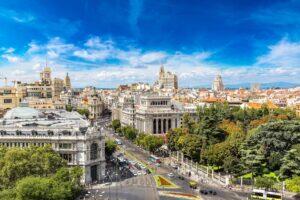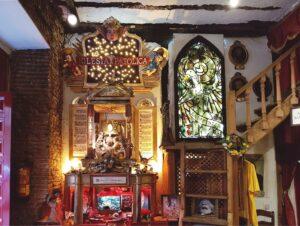Fodor's Expert Review Museo Nacional del Prado
One of the world's top museums, the Prado is to Madrid what the Louvre is to Paris: an iconic landmark that merits a visit by every traveler who comes to the city.
King Carlos III commissioned the construction of the Prado in 1785 as a natural science museum, the nucleus of a larger complex encompassing the adjoining botanical gardens and elegant Paseo del Prado. But when the building was completed in 1819, the royal family opted to turn it into a museum showcasing the art gathered by Spanish royalty since the time of Fernando and Isabel. In the 21st century the museum got a new building and wing resurrecting long-hidden works by Zurbarán and Antonio de Pereda and more than doubling the number of paintings on display from the permanent collection.
The Prado's jewels are by the nation's three great masters, Goya, Velázquez, and El Greco, though the museum also holds masterpieces by Flemish, Dutch, German, French, and Italian artists, collected when their lands were part... READ MORE
One of the world's top museums, the Prado is to Madrid what the Louvre is to Paris: an iconic landmark that merits a visit by every traveler who comes to the city.
King Carlos III commissioned the construction of the Prado in 1785 as a natural science museum, the nucleus of a larger complex encompassing the adjoining botanical gardens and elegant Paseo del Prado. But when the building was completed in 1819, the royal family opted to turn it into a museum showcasing the art gathered by Spanish royalty since the time of Fernando and Isabel. In the 21st century the museum got a new building and wing resurrecting long-hidden works by Zurbarán and Antonio de Pereda and more than doubling the number of paintings on display from the permanent collection.
The Prado's jewels are by the nation's three great masters, Goya, Velázquez, and El Greco, though the museum also holds masterpieces by Flemish, Dutch, German, French, and Italian artists, collected when their lands were part of the Spanish Empire. The museum benefited greatly from the anticlerical laws of 1836, which forced monasteries, convents, and churches to forfeit many of their artworks for public display.
Enter the Prado via the Goya entrance, with steps opposite the Mandarin Oriental Ritz hotel. The layout varies (grab a floor plan), but the first halls on the left coming from the Goya entrance (Rooms 7A–11 on the second floor) are usually devoted to 17th-century Flemish painters, including Peter Paul Rubens (1577–1640), Jacob Jordaens (1593–1678), and Anthony van Dyck (1599–1641).
Room 12 introduces you to the meticulous brushwork of Velázquez (1599–1660) in his numerous portraits of kings and queens. Look for Las Hilanderas (The Spinners), evidence of the artist's talent for painting light. The Prado's most famous canvas, Velázquez's Las Meninas (The Maids of Honor), combines a self-portrait of the artist at work with a mirror reflection of the king and queen in a revolutionary interplay of space and perspectives. Picasso was obsessed with this work and painted several copies of it—now on display in the Picasso Museum in Barcelona—in his own abstract style.
The south ends of the second and top floors (primera planta and segunda planta) are reserved for Goya (1746–1828), whose works range from the bucolic to the horrific in tone. Among his early masterpieces are portraits of the family of King Carlos IV, for whom he was court painter. One glance at their unflattering and imbecilic expressions, especially in The Family of Carlos IV, reveals the loathing Goya developed for these self-indulgent, reactionary rulers. His famous side-by-side canvases, The Clothed Maja and The Nude Maja, may represent the young Duchess of Alba, whom Goya adored and frequently painted. No one knows whether she ever returned his affection. The adjacent rooms house a series of idyllic scenes of Spaniards at play, painted as designs for tapestries.
Goya's paintings grew political around 1808, when Madrid rose up against occupying French troops. The 2nd of May portrays the insurrection at the Puerta del Sol, and its even more terrifying companion piece, The 3rd of May, depicts the nighttime executions of patriots who had rebelled the day before. The garish light in this work typifies the romantic style, which favors drama over detail, and makes it one of the most powerful indictments of violence ever committed to canvas. Goya's "Black Paintings" are dark, disturbing works, completed late in his life, that reflect his inner turmoil after losing his hearing and his embitterment over the bloody War of Independence. These are copies of the enormous, hallucinatory paintings Goya made with marvelously free brushstrokes on the walls of his house (known as La Quinta del Sordo: "the Deaf One's Villa"), situated near the Manzanares River. Don't miss the terrifying Saturn Devouring One of His Sons (which Goya displayed in his dining room!), a painting that communicates the ravages of age and time.
The Prado's ground floor (planta baja) is filled with 15th- and 16th-century Flemish paintings, including the bizarre proto-surrealist masterpiece Garden of Earthly Delights by Hieronymus Bosch (circa 1450–1516). In Rooms 60A, 61A, and 62A, contemplate the passionately spiritual works of El Greco (Doménikos Theotokópoulos, 1541–1614), the Greek-born artist who lived and worked in Toledo, known for his mystical elongated forms and faces—a style that was shocking to a public accustomed to strictly representational images. Two of his greatest paintings, The Resurrection and The Adoration of the Shepherds, are on view here. Before you leave, stop in the 14th- to 16th-century Italian rooms to see Titian's Portrait of Emperor Charles V and Raphael's Portrait of a Cardinal.
Buy tickets in advance online; to save a few bucks on an audio guide, download the Prado Museum Visitor Guide app ahead of your visit.
READ LESS








